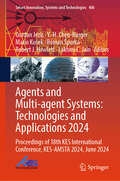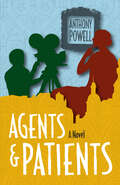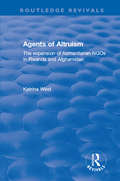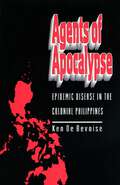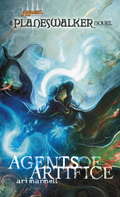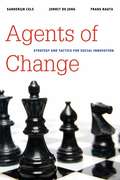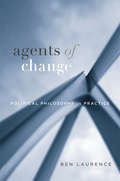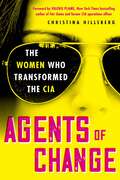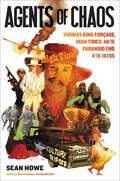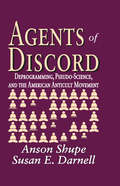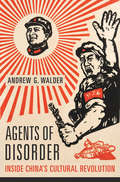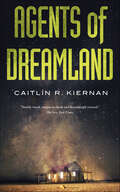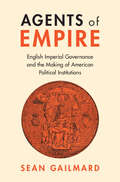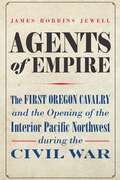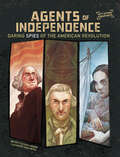- Table View
- List View
Agents and Multi-agent Systems: Proceedings of 17th KES International Conference, KES-AMSTA 2023, June 2023 (Smart Innovation, Systems and Technologies #354)
by Lakhmi C. Jain Gordan Jezic J. Chen-Burger M. Kusek R. Sperka R. J. HowlettThis book highlights new trends and challenges in research on agents and the new digital and knowledge economy. It includes papers on business process management, agent-based modeling and simulation and anthropic-oriented computing that were originally presented at the 17th International KES Conference on Agents and Multi-Agent Systems: Technologies and Applications (KES-AMSTA 2023), held in Rome, Italy, in June 14–16, 2023. The respective papers cover topics such as software agents, multi-agent systems, agent modeling, mobile and cloud computing, big data analysis, business intelligence, artificial intelligence, social systems, computer embedded systems and nature-inspired manufacturing, all of which contribute to the modern digital economy.
Agents and Multi-agent Systems: Proceedings of 18th KES International Conference, KES-AMSTA 2024, June 2024 (Smart Innovation, Systems and Technologies #406)
by Lakhmi C. Jain Robert J. Howlett Gordan Jezic Roman Šperka Y.-H. Chen-Burger Mario KušekThis book highlights new trends and challenges in research on agents and the new digital and knowledge economy. It includes papers on business process management, agent-based modeling and simulation and anthropic-oriented computing that were originally presented at the 18th International KES Conference on Agents and Multi-Agent Systems: Technologies and Applications (KES-AMSTA 2024), held in Madeira, Portugal, on June 19–21, 2024. The respective papers cover topics such as software agents, multi-agent systems, agent modeling, mobile and cloud computing, big data analysis, business intelligence, artificial intelligence, social systems, computer-embedded systems and nature-inspired manufacturing, all of which contribute to the modern digital economy.
Agents and Patients: A Novel
by Anthony PowellUnsavory artists, titled boobs, and charlatans with an affinity for Freud such are the oddballs whose antics animate the early novels of the late British master Anthony Powell. A genius of social satire delivered with a very dry wit, Powell builds his comedies on the foibles of British high society between the wars, delving into subjects as various as psychoanalysis, the film industry, publishing, and (of course) sex. More explorations of relationships and vanity than plot-driven narratives, these slim novels reveal the early stirrings of the unequaled style, ear for dialogue, and eye for irony that would reach their caustic peak in Powell s epic "A Dance to the Music of Time. " In "Agents and Patients," we return to London with the newly wealthy, memorably named Blore-Smith: an innocent, decent enough chap . . . and a drip. Vulnerable to the machinations of those with less money and more lust, Blore-Smith falls victim to two con artists whose ploys carry him through to the art galleries and whorehouses of Paris, Berlin, and beyond. Written from a vantage point both high and necessarily narrow, Powell s early novels nevertheless deal in the universal themes that would become a substantial part of his oeuvre: pride, greed, and what makes people behave as they do. Filled with eccentric characters and piercing insights, Powell s work is achingly hilarious, human, and true. "
Agents and Robots for reliable Engineered Autonomy: 4th Workshop, AREA 2024, Santiago de Compostela, Spain, October 19, 2024, Proceedings (Communications in Computer and Information Science #2230)
by Angelo Ferrando Rafael C. CardosoThis book constitutes the proceedings of the 4th Workshops on Agents and Robots for Reliable Engineered Autonomy, AREA 2024, which took place in Santiago de Compostela, Spain, on October 19, 2024, in conjunction with ECAI 2024. The 9 full papers and 1 short paper included in this book were carefully reviewed and selected from 14 submissions. They deal with agent-oriented software engineering, robotic applications, formal verification, and artificial intelligence.
Agents and Structures in Cross-Border Governance: North American and European Perspectives
by Tony Payan Bruno Dupeyron Andrea NoferiniIn North America and Europe, cross-border governance arrangements have provided formal and informal frameworks to support cross-border cooperation. Analysing how these frameworks have emerged, the ways in which they have become institutionalized, and the processes by which they change is fundamental. Moreover, these frameworks are increasingly challenged by border securitization, thus limiting or jeopardizing decades of cross-border cooperative governance and coordinated public policies. Agents and Structures in Cross-Border Governance offers a series of case studies that explore these complex dynamics. To understand a range of cross-border governance frameworks, this collection addresses such topics as infrastructure development and management, resource sharing, regional politics, economics, security, human rights, the environment, culture, and community. The book explains how cross-border governance schemes have sought to mitigate some of the negative consequences of border security policies, allowing readers to discern how concrete national power struggles between federal/national and subnational governments unfold in border areas. In a world increasingly impacted by climate change and more recently the COVID-19 pandemic, Agents and Structures in Cross-Border Governance sheds light on the ongoing complexity of cross-border governance and offers lessons to help mitigate these challenges.
Agents of Altruism: The Expansion of Humanitarian NGOs in Rwanda and Afghanistan (Routledge Revivals)
by Katrina WestThis title was first published in 27/11/2001: Humanitarian nongovernmental organizations (NGOs) grew significantly in the last decades of the 20th century. The international NGO community today is a rich world of professional bodies, local organizations, mammoth multinationals, charities, advocacy groups, business-like organizations, ad hoc agencies and voluntary associations. Humanitarian NGOs are powerful actors in conflict regions and influential campaigners at the international level. What are the reasons behind their growth? In answering that question, this book focuses on how and when NGOs became influential in humanitarian crises. Four case studies in Rwanda and Afghanistan are examined. The earliest is the crisis in Rwanda in the 1960s, when only a few NGOs operated in Rwanda with limited budgets and experience. The second case study is the Soviet invasion of Afghanistan in 1979-89, by which time NGOs had developed considerably: by then they were operating on a global scale, receiving more funds, having closer ties with the media, executing bigger projects and had also become more professional. The second Afghan case study focuses on the mujahidin and Taliban rule, while the second Rwandan study centres on the 1994 genocide. These two studies reveal that enormous changes have taken place in the humanitarian NGO community since the 1980s. In this way, this book characterizes the changes that have taken place and then offers explanations for the nature and speed of the growth and change.
Agents of Apocalypse: Epidemic Disease in the Colonial Philippines
by Ken De BevoiseAs waves of epidemic disease swept the Philippines in the late nineteenth century, some colonial physicians began to fear that the indigenous population would be wiped out. Many Filipinos interpreted the contagions as a harbinger of the Biblical Apocalypse. Though the direct forebodings went unfulfilled, Philippine morbidity and mortality rates were the world's highest during the period 1883-1903. In Agents of Apocalypse, Ken De Bevoise shows that those "mourning years" resulted from a conjunction of demographic, economic, technological, cultural, and political processes that had been building for centuries. The story is one of unintended consequences, fraught with tragic irony.De Bevoise uses the Philippine case study to explore the extent to which humans participate in creating their epidemics. Interpreting the archival record with conceptual guidance from the health sciences, he sets tropical disease in a historical framework that views people as interacting with, rather than acting within, their total environment. The complexity of cause-effect and agency-structure relationships is thereby highlighted. Readers from fields as diverse as Spanish, American, and Philippine history, medical anthropology, colonialism, international relations, Asian studies, and ecology will benefit from De Bevoise's insights into the interdynamics of historical processes that connect humans and their diseases.
Agents of Artifice
by Ari MarmellIn this struggle for influence and power, for the keys to magical knowledge, everything you knew about novels based on Magic: The Gathering® is changing . . . Jace Beleren is a planeswalker who has taken the path of least resistance. He is gifted and powerful, but chooses not to push himself. Part of an inter-planar consortium that deals in magical artifacts, Jace has some power and influence. He also has a certain amount of security. That's all about to change. When Liliana, a dark temptress with demons of her own (quite literally), comes into his life, she brings with her more possibilities, but also more problems. Under attack from external interests, a friend dies because of decisions Jace made. Upset with himself and fearing for his life, Jace sets out to find who is behind this new threat. What he uncovers along the way, an inter-planar chase filled with peril, will alter everything he knows.From the Paperback edition.
Agents of Bioterrorism: Pathogens and Their Weaponization
by Geoffrey ZubayThis new work offers a clear and thorough account of the threats posed by bioterrorism from the perspective of biologists. The authors examine thirteen disease-causing agents, including those responsible for anthrax, the plague, smallpox, influenza, and SARS. Each chapter considers a particular pathogen from the standpoint of its history, molecular biology, pathology, clinical presentation, diagnosis, weaponization, and defenses. The book also examines strategies for making vaccines and protecting the population in a bioterror attack.
Agents of Change
by Frans Nauta Sanderijn Cels Jorrit De JongWhile governments around the world struggle to maintain service levels amid fiscal crises, social innovators are improving social outcomes for citizens by changing the system from within. In Agents of Change, three cutting-edge thinkers and entrepreneurs present case studies of social innovation that have led to significant social change. Drawing on original empirical research in the United States, Canada, Japan, Germany, Denmark, and the Netherlands, they examine how ordinary people accomplished extraordinary results.Sanderijn Cels, Jorrit de Jong, and Frans Nauta offer lively illustrations and insightful interpretations of how innovators, social entrepreneurs, and change agents are dealing with powerful opponents, the burdens of bureaucracy, and the challenge of securing resources and support. This book will appeal to anyone who is intrigued by imaginative, cross-boundary thinking and transformative change. It will be of particular interest to those who want to know how exactly innovators pull it off. With practitioners, scholars, and students of public policy and management in mind, the authors dissect the strategies and tactics that social innovators employ to navigate the risky waters of their institutional environments.Contents Part 1: Introduction: Chess Masters and Acrobats 1. Strategy and Tactics2. Crafting the Case: The Art of Making a Start3. Prompting Progress: The Art of Making Things Happen4. Managing Meaning: The Art of Making SensePart 2: Front-Line Innovations 5. Under the Radar: Medical Informatics in Japan6. Relentless Incrementalism: Financial Literacy Training for Newcomers in Canada7. Join the Club! Alzheimer Cafés in the Netherlands8. Just a Tool? Implementing the Vulnerability Index in New OrleansPart 3: Innovations in Governance 9. The Sun Kings: Solar Energy in Germany10. Change on Steroids: Public Education in New Orleans11. The Value of Values: Higher Education in Virginia12. A Window of Opportunity: Institutional Reform in DenmarkConclusion: Innovating Strategically
Agents of Change: Enzymes in Milk and Dairy Products (Food Engineering Series)
by Alan L. Kelly Lotte Bach LarsenThe enzymology of milk and other products is of enormous significance for the production and quality of almost every dairy product. Milk itself is a complex biological fluid that contains a wide range of enzymes with diverse activities, some of which have identifiable functions while others are present as an accidental consequence of the mechanism of milk secretion. Over time milk enzymology has become an incredibly essential component of milk and other dairy product production, and with advancing technology and processing techniques, its importance is at its peak. Dairy Enzymology presents an expansive overview of the enzymology of milk and other dairy products, focusing on the use of indigenous and endogenous enzymes in milk and exogenous enzymes in cheese processing. A full section is dedicated to the enzymology of bovine milk, focusing on the main families of indigenous enzymes as well as their potential significance in the mammary gland plus the technological significance for the properties of dairy products. Implications for the manufacture and ripening of cheese plus the use of enzymes such as alkaline phosphatase for measuring heat treatment in milk are explored in full, and the role of milk protease plasmin and other indigenous enzymes in the age-gelation is focused on. Further sections focus on enzymes found in raw milk and enzymes deliberately added for manufacture or modification of properties and the manufacture of food ingredients from dairy-derived ingredients. The key bacterial families are discussed in depth as well as their known contributions to the quality of dairy products. With its comprehensive scope and fully up-to-date coverage of dairy product enzymology, this text is a singular source for researchers looking to understand this essential dairy processing aspect.
Agents of Change: Political Philosophy in Practice
by Ben LaurenceAn incisive argument for the relevance of political philosophy and its possibility of effecting change. The appeal of political philosophy is that it will answer questions about justice for the sake of political action. But contemporary political philosophy struggles to live up to this promise. Since the death of John Rawls, political philosophers have become absorbed in methodological debates, leading to an impasse between two unattractive tendencies: utopians argue that philosophy should focus uncompromisingly on abstract questions of justice, while pragmatists argue that we should concern ourselves only with local efforts to ameliorate injustice. Agents of Change shows a way forward. Ben Laurence argues that we can combine utopian justice and the pragmatic response to injustice in a political philosophy that unifies theory and practice in pursuit of change. Political philosophy, on this view, is not a purely normative theory disconnected from practice. Rather, political philosophy is itself a practice—an exercise of practical reason issuing in action. Laurence contends that this exercise begins in ordinary life with the confrontation with injustice. Philosophy draws ideas about justice from this encounter to be pursued through political action. Laurence shows that the task of political philosophy is not complete until it asks the question “What is to be done?” and deliberates actionable answers.
Agents of Change: Strategy and Tactics for Social Innovation
by Frans Nauta Sanderijn Cels Jorrit De JongWhile governments around the world struggle to maintain service levels amid fiscal crises, social innovators are improving social outcomes for citizens by changing the system from within. In Agents of Change, three cutting-edge thinkers and entrepreneurs present case studies of social innovation that have led to significant social change. Drawing on original empirical research in the United States, Canada, Japan, Germany, Denmark, and the Netherlands, they examine how ordinary people accomplished extraordinary results.Sanderijn Cels, Jorrit de Jong, and Frans Nauta offer lively illustrations and insightful interpretations of how innovators, social entrepreneurs, and change agents are dealing with powerful opponents, the burdens of bureaucracy, and the challenge of securing resources and support. This book will appeal to anyone who is intrigued by imaginative, cross-boundary thinking and transformative change. It will be of particular interest to those who want to know how exactly innovators pull it off. With practitioners, scholars, and students of public policy and management in mind, the authors dissect the strategies and tactics that social innovators employ to navigate the risky waters of their institutional environments.Contents Part 1: Introduction: Chess Masters and Acrobats 1. Strategy and Tactics2. Crafting the Case: The Art of Making a Start3. Prompting Progress: The Art of Making Things Happen4. Managing Meaning: The Art of Making SensePart 2: Front-Line Innovations 5. Under the Radar: Medical Informatics in Japan6. Relentless Incrementalism: Financial Literacy Training for Newcomers in Canada7. Join the Club! Alzheimer Caf?s in the Netherlands8. Just a Tool? Implementing the Vulnerability Index in New OrleansPart 3: Innovations in Governance 9. The Sun Kings: Solar Energy in Germany10. Change on Steroids: Public Education in New Orleans11. The Value of Values: Higher Education in Virginia12. A Window of Opportunity: Institutional Reform in DenmarkConclusion: Innovating Strategically
Agents of Change: The Women Who Transformed the CIA
by Christina HillsbergThe timely and revelatory exploration of the pioneering women who changed the insulated world of international espionage—from the barrier-crashing challenges of the 1960s to the present day reckoning—told through the eyes of a former intelligence operative herself. Foreword by Valerie Plame, New York Times bestselling author of Fair Game and former CIA operations officer Years after her successful and impactful career at the CIA, Christina Hillsberg became enthralled with the stories of the trailblazing women who forged new paths within the Agency long before she began her career there in the aughts. These were women who sacrificed their personal lives, risked their safety, defied expectations, and boldly navigated the male-dominated spy organization. Through exclusive interviews with current and former female CIA officers, many of whom have never spoken publicly, Agents of Change tells an enthralling and, at times, disturbing story set against the backdrop of the evolving women&’s movement. It was the 1960s, a &“secretarial&” era, when women first gained a foothold and pushed against the one-dimensional, pop-culture trope of the sexy Cold War Bond Girl. Underestimated but undaunted, they fought their way, decade-by-decade, through adversity to the top of the spy game. Seamlessly weaving together the individual stories of these exceptional women, Hillsberg deftly tackles not just the fight for gender equality at the CIA, but the current dilemma the Agency faces when dealing with the culmination of a decades-long culture of sexual harassment and assault. Each chapter sheds a light on women&’s issues during that decade before bringing to life the stories of female CIA operations officers whose experiences were emblematic of that given era. In this fascinating and empowering chronicle, Hillsberg takes readers inside the Agency in a way that&’s never been done before, paying long overdue tribute to the survivors and thrivers, the indispensable groundbreakers, and defiant rabble-rousers who made the choice to change their lives and in turn, changed history.
Agents of Chaos: Thomas King Forçade, High Times, and the Paranoid End of the 1970s
by Sean HoweThe life and times of High Times&’ enigmatic founder Thomas King Forçade, an underground newspaper editor and marijuana kingpin who—between police raids, smuggling runs, and outrageous stunts—battled both the US government and fellow radicals.Cover illustration by legendary comics artist Bill Sienkiewicz. At the end of the 1960s, the mysterious Tom Forçade suddenly appeared, insinuating himself into the top echelons of countercultural politics and assuming control of the Underground Press Syndicate, a coalition of newspapers across the country. Weathering government surveillance and harassment, he embarked on a landmark court battle to obtain White House press credentials. But his audacious exploits—pieing Congressional panelists, stealing presidential portraits, and picking fights with other activists—led to accusations that he was an agent provocateur. As the era of protest faded and the dark shadows of Watergate spread, Forçade hoped that marijuana could be the path to cultural and economic revolution. Bankrolled by drug-dealing profits, High Times would be the Playboy of pot, dragging a once-taboo subject into the mainstream. The magazine was a travelogue of globe-trotting adventure, a wellspring of news about &“the business,&” and an overnight success. But High Times soon threatened to become nothing more than the &“hip capitalism&” Forçade had railed against for so long, and he felt his enemies closing in. Assembled from exclusive interviews, archived correspondences, and declassified documents, Agents of Chaos is a tale of attacks on journalism, disinformation campaigns, governmental secrecy, corporatism, and political factionalism. Its triumphs and tragedies mirror the cultural transformations of 1970s America, wrought by forces that continue to clash in the spaces between activism and power.
Agents of Darkness
by Campbell ArmstrongIn international bestselling author Campbell Armstrong's thrilling, sophisticated tale of espionage, an assassin's vengeance triggers the exposure of a lethal conspiracy at the heart of the US government The director of the CIA lies unconscious and close to death in a private clinic, and his likely successor waits on his Pennsylvania estate while the power brokers in Washington, DC, do their deals. In the meantime, a man in Dallas is murdered. And on the other side of the globe, in Manila, a nondescript American is killed in his lover's back-alley apartment. Hard-drinking Scotsman Charlie Galloway, who has been suspended from his job in the LAPD, unofficially looks into the murder of a Filipino woman. Step by step, his investigation leads him to the nation's capital, where a shocking conspiracy reaches deep into the heart of government. [Reviews]
Agents of Discord: Deprogramming, Pseudo-Science, and the American Anticult Movement
by Susan E. Darnell Anson Shupe"It is widely acknowledged that the United States has always provided fertile ground for the growth of new religious movements and cults, but modern organized efforts to oppose and restrict them have been less well understood. In Agents of Discord, Anson Shupe and Susan E. Darnell offer a groundbreaking analysis of the operations and motives of these oppositional groups, which they generally group under the umbrella term of the anticult movement.Historically there have always been parallel groups opposed to certain religious movements, whether these be anti-Quaker, anti-Roman Catholic, or anti-Mormon. The authors establish the cultural context of such movements in the nineteenth century. They point out the link between modern anticult movements and nativist movements in American history. Turning to the postwar era, the authors discuss the rise of anticult movements and focus specifically on one of the most prominent, the Cult Awareness Network (CAN). CAN was a two-tiered organization. Partly composed of volunteers, donors, and families affected by cult movements, it also included what the authors call an ""inner sanctum"" of behavioral science professionals, attorneys, and deprogrammers. Using never-before-reported data on CAN's activities, the authors cite an extensive history of financial impropriety that finally led to the organization's bankruptcy. They offer a pointed critique, informed by current scholarship, of the ""brainwashing"" model of mental enslavement presented by the anticult movement that has been a central assumption undergirding its activities. At the same time, they show how increasing professionalization has gradually begun a shift of such movements to a therapeutic model of exit counseling that rejects the crude methods of earlier intervention strategies.In their analysis of the anticult movement nationally and internationally, Shupe and Darnell merge sociological concepts and social history to make unique sense of a hereto"
Agents of Disorder: Inside China’s Cultural Revolution
by Andrew G. WalderWhy did the Chinese Communist Party state collapse so rapidly during the Cultural Revolution? Consulting over 2,000 local annals chronicling some 34,000 revolutionary episodes across China, Andrew Walder offers a new answer, showing how the army, brought in to quiet brewing rebellions, escalated the violence that took nearly 1.6 million lives.
Agents of Dreamland (Tinfoil Dossier #1)
by Caitlín R. Kiernan“[In this] Lovecraft-inflected police procedural . . . Kiernan’s writing—starkly visual, tongue in cheek and disturbingly visceral—carries the day.” —New York TimesA government special agent known only as the Signalman gets off a train on a stunningly hot morning in Winslow, Arizona. Later that day he meets a woman in a diner to exchange information about an event that happened a week earlier for which neither has an explanation, but which haunts the Signalman.In a ranch house near the shore of the Salton Sea a cult leader gathers up the weak and susceptible—the Children of the Next Level—and offers them something to believe in and a chance for transcendence. The future is coming and they will help to usher it in.A day after the events at the ranch house which disturbed the Signalman so deeply that he and his government sought out help from ‘other’ sources, Johns Hopkins Applied Physics Laboratory abruptly loses contact with NASA’s interplanetary probe New Horizons. Something out beyond the orbit of Pluto has made contact.And a woman floating outside of time looks to the future and the past for answers to what can save humanity.Agents of Dreamland is a new Lovecraftian horror novella from award-winning author Caitlín R. Kiernan.“Kiernan’s subtly haunting voice draws the reader in.” —Publishers Weekly“Caitlín R Kiernan is one of those writers that you can’t believe isn’t a household name. Her writing is fantastic and her stories are dark, complex and wonderful.” —Book Riot
Agents of Empire
by Lisa ChiltonThe period between the 1860s and the 1920s saw a wave of female migration from Britain to Canada and Australia, much of which was managed by women. In Agents of Empire, Lisa Chilton explores the work of the women who promoted, managed, and ultimately transformed single British women's experiences of migration.Chilton examines the origins of women-run female emigration societies through various aspects of their work and the responses they received from emigrants and settled colonists. Working in the face of apathy in the community, resistance by other (usually male) managers of imperial migration, and agency exerted by the women they sought to manage, the emigrators endeavoured to maintain control over the field until government agencies took it over in the aftermath of the First World War. Agents of Empire highlights the aims and methods behind the emigrators' work, as well as the implications and ramifications of their long-term engagement with this imperialistic feminizing project. Chilton provides tremendous insight into the struggle for control of female migration and female migrants, aiding greatly in the study of gender, migration, and empire.
Agents of Empire: English Imperial Governance and the Making of American Political Institutions
by Sean GailmardTo understand the foundations of American political institutions, it's necessary to understand the rationale for British colonial institutions that survived the empire. Political institutions in England's American colonies were neither direct imports from England, nor home-grown creations of autonomous colonists. Instead, they emerged from efforts of the English Crown to assert control over their colonies amid limited English state and military capacity. Agents of Empire explores the strategic dilemmas facing a constrained crown in its attempts to assert control. The study argues that colonial institutions emerged from the crown's management of authority delegated to agents-first companies and proprietors establishing colonies; then imperial officials governing the polities they created. The institutions remaining from these strategic dynamics form the building blocks of federalism, legislative power, separation of powers, judicial review, and other institutions that comprise the American polity today.
Agents of Empire: The First Oregon Cavalry and the Opening of the Interior Pacific Northwest during the Civil War
by James Robbins JewellAgents of Empire expands the historiographical scope of Civil War studies to include the war&’s intersection with the history of the American West, demonstrating how the war was transcontinental in scope. Much more than a traditional Civil War regimental history, James Robbins Jewell&’s work delves into the operational and social conditions under which the First Oregon Cavalry Regiment was formed. In response to ongoing tensions and violent interactions with Native peoples determined to protect their way of life and lands, Colonel George Wright, head of the military&’s District of Oregon, asked the governor of Oregon to form a voluntary cavalry unit to protect white settlers and farmers. By using local volunteers, and later two additional regiments of infantry from the region, the federal government was able to draw from the majority of Regular Army troops stationed in the Pacific Northwest, who were eventually sent to fight Confederate forces east of the Mississippi River. Had the First Oregon Cavalry failed to fulfill its responsibilities, the federal government would have had to recall Union forces from other threatened areas and send them to Oregon and Washington Territory to quell secessionist unrest and Indigenous resistance to land theft, resource appropriation, and murder. The First Oregon Cavalry ensured settlers&’ security in the Union&’s farthest northwest corner, thereby contributing to the Union cause.
Agents of Flourishing: Pursuing Shalom in Every Corner of Society (Made to Flourish Resources)
by Amy L. ShermanGod calls Christians to participate in his redemptive mission in every sphere of life.
Agents of Grace: How to Bridge Divides and Love as Jesus Loved
by Daniel DarlingPolitical division. Racial tension. Vaccine wars. In Agents of Grace, award-winning writer, journalist, and podcast host Daniel Darling equips us to discern what's worth fighting for, how to move beyond our profound disagreements, and how to live as agents of Jesus's love.When Daniel Darling was fired as spokesperson for the National Religious Broadcasters Association, it wasn't his exit that made national news--it was the way he handled it. Daniel's charitable response to those he had worked with was so radical that it made headlines. But why has kindness among Christians become so startling?In Agents of Grace, Daniel explores practical ways we can follow the Bible's command to "strive actively for peace" even in a painfully divided church, country, and world. On a very personal level, he helps us climb out of cynicism about how the people of God treat each other, especially when we are trying to heal from such pain in our own lives.Beautifully written, Agents of Grace draws on modern-day examples and biblical truths to address:Divisions that keep us from obeying Jesus's command to love one anotherVirtues that will lead us to a peace-filled lifeThe theological differences that are worth fighting for, and those that are notHow to avoid apathy and heal from past hurt, even amid hypocrisy and corruptionThe difference between forgiveness, reconciliation, and trust In this hope-filled book, Daniel issues a clarion call to live as bridgebuilders in a divided country, healers in a hurting church, and countercultural Jesus-followers in a world that needs to know God's love.
Agents of Independence
by Matthew K. ManningAmerica’s first president masterminds a network of spies. A young officer creates a clever spy ring. A patriotic woman uses her laundry as a secret code. These thrilling, true stories of espionage shifted the course of the American Revolution. How did these bold spies manage to outfox the British and contribute to the fight for independence? Jam-packed with dynamic paneled art and leveled text, this hi-lo graphic novel will thrill reluctant and at-level readers while showcasing some of history’s most mysterious heroes.

